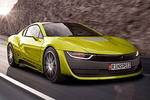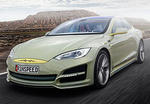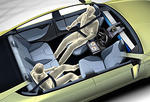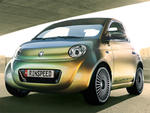
World premiere at the Geneva Motor Show 2007.
"Glass" concept car to mark Rinspeed's 30th birthday - 40 years after Bayer's first "all-plastic" car
eXasis - Glass-free transparency
Zumikon / Leverkusen – "There's never been anything like it" were the words used in the online edition of an acclaimed international news magazine to describe its editor's reaction when the first sketches of the new Rinspeed concept car, "eXasis", appeared on the Internet, "and it looks like no other vehicle before it". In fact, the illustrations could only hint at what Swiss automotive visionary Frank M. Rinderknecht had
thought up in collaboration with the experts from Bayer MaterialScience AG – one of the largest plastics producers in the world – to mark his company's 30th anniversary: a drivable "glass" car with a completely transparent body and floor made of Makrolon. Once again, this Rinspeed creation has been built by the Swiss engineering specialists Esoro, and will be shown to the public for the first time at the Geneva Motor Show (March 8-18, 2007), 40 years after Bayer presented the first "all-plastic car" at the K67 Plastics Fair in Germany in 1967.
"Everyone who sees the Rinspeed eXasis for the first time raves about the glass car, but they actually mean our transparent high-tech plastic," says Ian Paterson, the member of the Bayer MaterialScience Board of Management responsible for Innovation, describing the typical reaction to the prototype. "Many people only talk about innovation. We do it, in conjunction with our partners." In fact, nearly all the Bayer MaterialScience business units were involved in the development of the concept car, providing products such as surface coatings and polyurethanes (for molding tools). but it was the plastics experts from BMS with their Makrolon
polycarbonate who were responsible for the transparency of the eXasis. Frank M. Rinderknecht: "In this ethereal transparency, the true spirit of the Rinspeed eXasis becomes visible. An abstract idea becomes material, visions become a tangible car. Yet the Rinspeed eXasis still doesn't seem to have quite arrived in our material world."
So is it just a clever 3D projection, a fata morgana or perhaps a four-wheel 'objet d'art'? In any case, the third vehicle to emerge from the cooperation between the two companies differs
fundamentally from the other two: the futuristic-looking "Senso" and the pure-blooded "zaZen" sports car. The eXasis is a completely new development, in other words it is not based on a production-line vehicle. The insect-like, shiny yellow body with the exposed wheels looks like a mix of the legendary Auto-Union racing cars from the first half of the last century and an off-road vehicle, offering room for two people, one behind the other. The reinterpretation of the frequently cited cigar form is crowned in the "sexy" rear section with an attractively integrated ventilator and a superb matching, highly polished Remus exhaust muffler. And the transparency also provides an unrestricted view of the compact 2-cylinder 750 ccm Weber engine, which, very unusually, sits above the transmission.
The Rinspeed eXasis is a real eye-catcher with nothing to hide. The outer Makrolon shell, molded by the Swiss firm Mecaplex and coated with a tinge of yellow by the German hard coatings specialist, KRD, reveals the vehicle's load-bearing aluminum chassis. The chassis looks as if it has been cut from a solid piece of material, and in fact the bulkheads are. Despite this, the entire construction exudes a sense of lightness like bamboo, underlined by a Lesonal chrome effect finish based on Bayer MaterialScience's Desmodur® and Desmophen. To finish the surfaces of the knobs and levers, the Bayer experts came up with a special soft-feel coating based on waterborne binders - their sole aim being to pamper the eyes and hands of the driver.
The two occupants sit in special seats designed in cooperation with Recaro. Each seat consists of twelve transparent Makrolon ribs – the same number as a human being has. The head restraint and armrests are made of transparent Technogel. The Hightex/Sellner Group, which is specialized in interior design, was responsible not only for the futuristic seat coverings and the design of the fabric-covered steering wheel, it has also added a number of other stylish highlights. One example is the innovative application of aluminized glass fiber material with a diamond-shape design on the wheel rims, trim, wishbones, fuel tank and headlamps.
The two transparent indicator and function displays are an absolute delight, both technically and optically. They seem to hover on both sides in the driver's field of vision. By touching them, various functions can be displayed and controlled. Each of the touch-panels is made of a transparent CD/DVD Makrolon blank that has been coated with electrically conductive Baytron from H.C. Starck to trigger the switch functions. The displays were developed by the Swiss safety and closure system specialists, Kaba. The personalized access system to the car is also be integrated in the touch panels.
The Rinspeed eXasis is powered by an extremely lightweight, 150 bhp Weber engine driven by CO2-emission-reducing bioethanol. In view of the fact that the car weighs only 750 kg because of its lightweight plastic construction, one horsepower has to shift only 5 kg – and that is about the same as a very nippy Porsche.
Rinspeed was also able to persuade some state-owned companies and government departments to become involved in the eXasis project. The fuel is provided by Alcosuisse, the profit center of the Swiss Alcohol Board, while the Swiss Federal Office of Energy has chosen the eXasis to take part in a study on the subject of lightweight construction and ecology. More information on bioethanol and Germany's first fuel station brand for environmentally friendly fuels can be found on the Internet at biofuel24.de.
To transfer all this power to the road, the KW chassis specialists have accommodated the tailor-made spring and shock absorber units vertically in the front in the partition wall and horizontally at the rear. The tires are Pirelli's 22-inch High-Performance P Zero, mounted on forged five-spoke wheels manufactured by the German wheel maker, AEZ. Here too, attention to detail is evident: the wheels are decorated with transparent "inlays" of Makrolon that look like small windows.
Despite the attractive sweeping contours that blend smoothly into the car's transparency, the eXasis is ‘edgy’ and definitely has a character of its own. But everybody who has the pleasure of driving it is agreed on one thing: glancing down through the transparent floor while the car is moving gives a very special kind of thrill…
Frank M. Rinderknecht used highly advanced technology and a Swiss-based network of top automotive specialists for his project. Although there is no automobile production in Switzerland, there is a very active automotive supply industry there. Many highly innovative prototypes have been developed and manufactured in Switzerland. engineered by Esoro - What you dream is what you get.
For the eighth time the Swiss engineering company Esoro was hired to serve as general contractor for the entire vehicle project. Esoro was responsible for project management, implementation of new technologies, engineering, design and manufacturing of the Rinspeed eXasis.
Esoro realized the concept with the help of its highly competent suppliers Schwaller AG (chassis), Weber Motor / Swissauto (engine) and Protoscar (styling). Starting with initial concepts, it took the highly skilled development team just six months to realize the entire project.
Esoro has been a contract developer in the areas of automotive production, lightweight design and plastics technology for 16 years. During this time it has gained a well-deserved reputation for excellent efficiency and innovative solutions not just in these but also in other fields, including fuel-cell vehicles and prototype design. Esoro has impressively demonstrated its expertise with numerous extraordinary prototypes.
Another recent development from Esoro is the new E-LFT production technology developed for Weber Fibertech. E-LFT makes large scale production of high-strength and lightweight composite parts affordable. E-LFT composite parts weigh 30-50 percent less than comparable steel parts. The tailgate of the new smart fortwo is actually produced with our E-LFT technology. Furthermore another production process for niche markets, like high performance cars, trucks and caravans is now introduced by ESORO to several OEM’s. The new and patented process called Melt Embossing does offer the possibility to produce high end thermoplastic composite parts with low initial invest for structural and semi-structural applications. Esoro is able to offer the entire service starting from topological optimization and explicit FE calculations trough to the delivery of the serial parts.
Rinspeed eXasis - why the Swiss Federal Office of Energy (SFOE) is involved in this project
The SFOE is interested in the eXasis concept for two main reasons: The vehicle is energy-efficient thanks to its lightweight construction and it is powered by renewable energy.
The most effective way to cut a motor vehicle’s fuel consumption is to reduce its body weight, and this in turn gives rise to other weight reductions: Lighter vehicle - lighter components - smaller and lighter engine.
The SFOE is of course well aware that the Rinspeed eXasis can never be brought onto the commercial market. However, components and assemblies based on its technology can certainly help cut fuel consumption. Viewed in this light, eXasis can function as a demonstration platform for lightweight (i.e. energy-efficient) components such as: seats, body panels and fenders.
The second reason for the SFOE’s involvement in this project concerns the fuel the vehicle uses: E85. This is a mixture comprising 15 percent petrol and 85 percent ethanol. Ethanol is a renewable bio-fuel that is largely CO2 neutral when burned. In the future it will become especially attractive once it can be marketed as a second-generation bio-fuel (i.e. use of the entire plant instead of just its fruit). Thanks to its high octane level, E85 can also be used in engines with a high compression ratio, and this in turn increases the engine’s level of efficiency.
Reduction of CO2 with bioethanol
By signing the protocol of Kyoto, Switzerland engaged to reduce the emission of climate affecting gas. Our law on CO2 requires that the emissions up to the year 2010 get reduced for 10 % compared with 1990. The use of bioethanol as fuel may be a contribution to reach this objective. During its project Etha+, Alcosuisse – a profit centre of the Swiss Alcohol Board – analyses the use and the competitive ability of ethanol blended petrol in Switzerland.
Bioethanol means ethyl alcohol obtained by fermentation of sugars in plants. The chemical formula of bioethanol is the same as for traditional ethanol (C2H5OH). Ethanol may only be named as bioethanol if it is produced from vegetable raw material like for example wood, beets, corn and grass. These renewable energy sources we know also as biomass.
Concerning the production and use of bioethanol as a fuel, Brazil is probably the most advanced country. There, bioethanol takes 22 % of the fuel needs. In the USA, more than 10 % of petrol is blended with more than 10 % bioethanol. In Sweden, the petrol that is blended with 5 % bioethanol gets distributed by the normal cannels and without any special label at the filling station.
Unleaded petrol as a blend with 5 % bioethanol reduces the emission of CO2 for about 3.5 % to 4.0 % per litre petrol replaced by bioethanol. That means there is a reduction of 1.6 kg to 1.8 kg CO2 emission. As long as the ethanol is produced only from renewable raw materials the production lasts CO2 neutral. The emission of greenhouse gas during the production and combustion of bioethanol get compensated by the plant's CO2 intake during its growth.
Several studies allowed express by concrete figures the reduction of CO2 emissions. Unleaded petrol blended with 5 % bioethanol provides for savings of 1.3 litres crude oil and 2.4 kg CO2equiv per added litre bioethanol on the same power density. If the total of Swiss petrol consumption was replaced by ethanol blended petrol, we reached an annual reduction of CO2 greenhouse gas emissions for over 600'000 tons.
However, from the production surplus from potatoes, grain, sugar beets and whey, there could be produced 45 million litre bioethanol today. This corresponds to 900 million litre petrol blended with 5 % bioethanol. That means about a fifth of the Swiss petrol consumption.
Due to the high labour costs and several legal regulations to be met, the prime costs in Switzerland are much higher than for example in Brazil. That's why, for an inland production of bioethanol, a protection by customs or contingents especially during the starting phase would be necessary. This might be difficult to agree with the current economic policy and the existing trade agreements. So, for politic and economic reasons it seems obviously to import the bioethanol. If this is also ecologically efficient, is undecided.
Actually, the largest part of bioethanol that is used for fuel purpose in Switzerland is produced by Borregaard Schweiz AG in Attisholz. The ethanol is obtained by fermentation of a by-product of the cellulose production. The raw material of this Swiss Bioethanol for fuel purpose is wood.
TECHNICAL DATA
Measurements
Length 3'700 mm
Width 1'960 mm
Height 1'284 mm
Wheelbase 2’500 mm
Track front 1’700 mm
Track rear 1’700 mm
Ground clearance 325 mm (245mm)
Empty weight approx. 750kg
Vmax
Top speed 210 km/h
Acceleration 0-100 km/h approx. 4.8 sec
Engine
Engine family Weber Motor MPE 750 Turbo
Displacement 750 ccm
Stroke 66 mm
Bore 85 mm
Cylinders 2
Valves 4
Compression ratio 9:1
Power output 150 PS
at 7500 /min
Max. torque 150 Nm
at 4500 /min
Type of fuel Ethanol
Propulsion
Power train Rear wheel drive
Gearbox Manual sequentiell
Gears 6
Suspension
Chassis Aluminium
Body Plastic
Seating capacity Recaro Innovation
Front brakes 380 mm - 6 piston
Rear brakes 355 mm - 4 piston
Front suspension Double wishbone
Rear suspension Double wishbone
Dampers/springs KW automotive
Steering Rack & pinion
Tires
Front tires 265/30-22
Front wheels AEZ 8.5 x 22“
Rear tires 295/25-22
Rear wheels AEZ 11 x 22“










